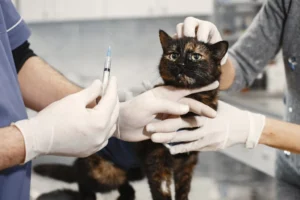Cats are mysterious creatures with unpredictable behavior. One moment they’re purring in your lap, and the next, they’re attacking your feet as you walk away. But why do cats have a tendency to strike when you turn your back on them?
Have you ever wondered why your feline friend seems to always go for the attack when your back is turned? It all comes down to a combination of instincts and communication methods unique to cats.
Instinctual Behavior of Cats
Cats are natural predators, and their instinctual behavior plays a significant role in why they may attack when you turn your back. When a cat sees your back turned, they may perceive it as an opportunity to pounce, mirroring how they would approach prey in the wild. Their instincts drive them to be agile and quick, making them more likely to exhibit playful or defensive behavior in this scenario. It’s essential to understand and respect your cat’s natural instincts to ensure a harmonious relationship with your feline friend.
Communication Through Body Language
Cats communicate primarily through body language, using subtle cues to convey their emotions and intentions. When you turn your back on a cat, you may inadvertently disrupt this communication, leading to a defensive or playful response. For example, a cat may interpret your turned back as a sign of vulnerability or a lack of attention, prompting them to engage in play or show aggression. By being aware of your cat’s body language and responding appropriately, you can avoid misunderstandings and strengthen your bond with your pet.
Key insights on cat behavior: 1. Tail position: A cat’s tail can indicate their mood, with an upright tail conveying confidence and a puffed-up tail signaling aggression. 2. Ears: Forward-facing ears suggest alertness, while flattened ears indicate fear or aggression. 3. Pupil dilation: Dilated pupils can signal excitement or aggression, while constricted pupils may indicate fear or aggression.
For more in-depth information on cat behavior and communication, you can explore reputable resources such as the American Society for the Prevention of Cruelty to Animals (ASPCA). Their insights can provide valuable guidance on understanding and interpreting your cat’s behavior more effectively.
Prey Drive and Play Behavior
Cats are natural hunters, and their prey drive is a strong instinct that guides a lot of their behavior. When you turn your back on a cat, they may see it as an opportunity to pounce and play as if they were hunting. This behavior is often fueled by their playful nature, as cats use stalking and pouncing as a way to hone their hunting skills. So, if your cat attacks you when your back is turned, it may just be their way of engaging in a game of “hunt and catch.”
Additionally, cats have a high level of energy that needs an outlet. Playing helps them burn off excess energy and stay mentally stimulated. If you turn your back and ignore them, they might interpret it as a cue to start a playful chase or ambush. To prevent surprise attacks, try engaging your cat in interactive play sessions where they can channel their hunting instincts in a positive way. Give them toys to chase and pounce on, and remember to reward them with treats for good behavior. By understanding and embracing your cat’s natural instincts, you can foster a stronger bond and prevent those unexpected attacks.
Trust and Vulnerability
When it comes to your cat’s behavior, trust plays a key role. Cats are creatures of habit and routine, and they thrive on feeling secure in their environment. If a cat feels threatened or vulnerable, they may resort to defensive behaviors like attacking when your back is turned. This could be a sign that your cat doesn’t fully trust you yet or feels anxious in certain situations.
Building trust with your cat is essential for a harmonious relationship. Spend quality time together, provide them with a safe and comfortable space, and be mindful of their body language to understand their needs better. By earning your cat’s trust and making them feel secure, you can reduce the likelihood of them lashing out when you’re not looking. Remember, patience and consistency are key when it comes to strengthening the bond with your feline friend.
Additional Unique Insight:
– Cats are experts at reading body language, so even subtle cues can affect how they perceive a situation. Pay attention to your own body language and try to project calm and confidence around your cat to help them feel more at ease. By creating a positive and relaxed environment, you can reduce the chances of your cat feeling the need to attack when your back is turned.
Ways to Redirect Aggression
If your cat tends to attack when you turn your back, here are some tips to help redirect their behavior. Firstly, try to anticipate when your cat might attack and intervene before it happens. Keep interactive toys handy to redirect their energy towards more appropriate outlets rather than your back. Additionally, training your cat to respond to commands like “no” or “stop” can be effective in curbing aggressive behaviors. Remember, consistency is key when implementing these redirection techniques.
Tips for Redirecting Aggression:
- Use interactive toys to redirect your cat’s energy.
- Train your cat to respond to commands like “no” or “stop.”
- Be consistent in implementing redirection techniques.
Always remember that aggression in cats can be a sign of underlying issues such as stress or boredom. If redirection techniques don’t seem to work, it’s essential to consult with a veterinarian or animal behaviorist for further guidance.
The Importance of Enrichment and Play
When it comes to understanding why cats attack when you turn your back, it’s crucial to consider the importance of providing mental and physical stimulation through enrichment and play. Cats are natural hunters and need outlets to express their predatory instincts. By engaging your cat in interactive play sessions daily, you can help satisfy their need for stimulation which can prevent unwanted behaviors like attacking.
Enrichment activities such as puzzle feeders, climbing trees, and interactive toys can keep your cat mentally stimulated and prevent boredom-induced aggression. Additionally, setting aside dedicated playtime each day can strengthen the bond between you and your feline friend while promoting healthy behaviors.
Remember, a mentally and physically enriched cat is a happy and well-behaved cat. Prioritize providing an environment that stimulates your cat’s natural behaviors, and you’ll likely see a decrease in aggressive tendencies when you turn your back.
For additional resources on cat enrichment and play, consider checking out this helpful article for more ideas and tips.
Understanding Cat Body Language
Do you often find yourself puzzled by your cat’s sudden attacks when you turn your back? Understanding your feline friend’s body language can be the key to preventing such unpleasant surprises. For instance, a twitching tail, flattened ears, or dilated pupils are all signs that your cat may be feeling agitated or defensive. By learning to interpret these cues, you can take steps to avoid triggering your cat’s aggressive behavior, even when you’re not facing them.
Building a Strong Bond with Your Cat
Creating a strong bond with your cat can significantly reduce the likelihood of them attacking when your back is turned. Spend quality time with your furry companion, engaging in activities they enjoy, such as interactive play sessions or grooming. By establishing trust and mutual respect, you can help your cat feel more secure and less inclined to lash out unexpectedly. Remember, a happy and well-bonded cat is less likely to resort to aggression as a form of communication.
Helpful Tip: Providing your cat with plenty of mental and physical stimulation, like puzzle toys or a window perch to watch birds, can also help channel their energy in a positive way, reducing the potential for attacks when you’re not looking.
Fun Facts About Cat Behavior
Did you know that when cats attack when you turn your back, it could be due to their natural hunting instincts kicking in? Cats are ambush predators, so they tend to pounce on moving objects, like your feet, as a way to practice their hunting skills. So, if you feel a sudden nip or scratch when your back is turned, your furry friend might just be honing their hunting techniques!
Another interesting fact is that cats have a highly evolved sense of smell, which plays a significant role in their behavior. When you turn your back, your scent trail becomes stronger, making it easier for your cat to track your movements. This heightened sense of smell might trigger a playful or predatory response in your feline friend.
Understanding these fun facts about cat behavior can give you valuable insights into why your cat exhibits certain behaviors, such as attacking when you turn your back. By recognizing and appreciating your cat’s natural instincts, you can better address and manage their behavior, strengthening your bond and creating a harmonious relationship with your pet.
Strategies to Address Cat Attacks When You Turn Your Back
Provide Enrichment : Keep your cat mentally stimulated and physically active with interactive toys, scratching posts, and puzzle feeders. Engaging your cat’s mind and body can help redirect their energy away from attacking you when your back is turned.
Maintain Routine : Cats thrive on routine, so establish consistent feeding times, play sessions, and grooming routines. Predictability in their daily schedule can help reduce stress and prevent sudden attacks when you turn your back.
Use Positive Reinforcement : When your cat displays appropriate behavior, such as refraining from attacking, reward them with treats, praises, or extra playtime. Positive reinforcement can encourage desirable behaviors and discourage undesirable ones.
Provide Outlets for Energy : Ensure your cat has ample opportunities to burn off excess energy through playtime, exercise, and exploration. An active cat is less likely to exhibit aggressive behavior, such as attacking when your back is turned.
Consult a Professional : If your cat’s attacks become frequent or severe, consider seeking guidance from a veterinarian or animal behaviorist. They can assess the underlying reasons for the behavior and provide tailored strategies to address and modify it effectively.
By implementing these strategies and understanding your cat’s behavior, you can minimize the likelihood of attacks when you turn your back and nurture a loving and respectful relationship with your feline companion. Remember, patience and consistency are key in shaping your cat’s behavior positively.
Alex, a passionate animal lover, has experience in training and understanding animal behavior. As a proud pet parent to two dogs and three cats, he founded AnimalReport.net to share insights from animal experts and expand his knowledge of the animal kingdom.









